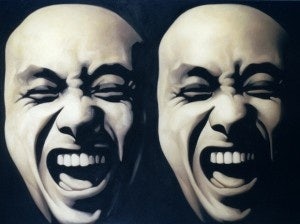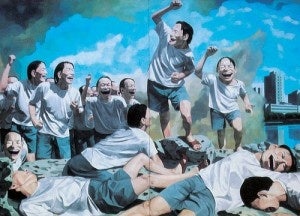1,463 Works By Top Artists Like Zhang Xiaogang & Zeng Fanzhi Included In Donation#

The big news this week in the Chinese art scene is the announcement that famed Chinese contemporary art collector Dr. Uli Sigg will donate over 1,000 pieces from his vast collection to Hong Kong's upcoming M+ Museum, due to open in 2017. Comprised of 1,463 works of art, valued conservatively at US$163 million, Sigg's incredible collection includes historically significant works by China's top blue-chip artists, among them Zhang Xiaogang, Liu Wei, Zeng Fanzhi and dozens of others. Along with these pieces, Sigg will sell an additional 47 works to the M+ Museum for US$22.7 million.
According to Randian Online, this donation and sale is the most dramatic development for M+ since the announcement of its formation, noting, "For one thing, the Sigg collection is the single most important collection of Chinese contemporary art and maps the emergence of an explosive contemporary art scene in Mainland China from the 1970s onwards. Meanwhile, M+ aims to be a cultural and critical center in the mold of Tate Modern in London or New York’s MoMA."
As Reuters writes today, Sigg's donation marks a major turning point in Hong Kong's long-delayed and troubled development of the 40-hectare West Kowloon Cultural District, which city administrators have been working to transform into the city's cultural epicenter. Hong Kong chief secretary and number two official, Stephen Lam, said this week that Sigg's bequest "will enable use to strengthen our position as the cultural hub in Asia." Dr. Lars Nittve, Executive Director of M+, said in a release that the as-yet-unbuilt museum is "thrilled" by Sigg's donation, adding, "Given both the fact that many works, especially from the first ten years of this period, were destroyed due to lack of interest from collectors and institutions and the subsequent boom in the market for these works, it would be impossible to now build a collection similar in depth, scope and quality."
Randian points out that M+ will reportedly dedicate over 5,000 square meters to the "M+ Sigg Collection" during the first three years of its opening, while M+ will, beginning this year, be engaged with the Chinese Contemporary Art Award (CCAA) founded by Sigg in 1997, as well as the linked Art Critic Award.

Despite this generous donation, M+, let alone Hong Kong, has a long way to go before becoming a major force on the global cultural scene. Later this year, an architectural design competition will be held in Hong Kong for the space, which is expected to open in 2017. So far, Hong Kong city administrators have green-lit HK$21.6 billion (US$2.8 billion) into the West Kowloon Cultural District in the hopes of reshaping Hong Kong into "an integrated arts and cultural district with world-class arts and cultural facilities."
Still, rabidly capitalistic Hong Kong has a long way to go before realizing its dream of becoming a cultural -- rather than simply economic -- power. Partly, this has to do with the city's history as a sourcing hub, in which a strong grassroots art scene never fully had a chance to materialize. As CNNGo wrote last month,
"Hong Kong is logistically an art hub," says Robin Peckham, whose newly founded Saamlung gallery has shown Hong Kong and Macau artists. "But a logistical hub is not an intellectual hub."
...
Peckham observed that many up-and-coming Hong Kong artists don't live in the city full-time -- Lee Kit lives in Taipei, Adrian Wong lives part-time in the United States -- whether to avoid rent pressure, find better jobs or to immerse themselves in a more nurturing art community.
Market pressures reduce the opportunity for Hong Kong artists to experiment and take risks. Local isn't what sells here and the boom in the city's international art trade is disproportionate to the slow ripening of the local art scene.

Regional competition from mainland China, Singapore, South Korea and others for world-class cultural and arts-based tourism complicates Hong Kong's ambitions, but the growing popularity of the Hong Kong International Art Fair (ART HK), the city's booming auction market and wine trade, less censorship, and now Uli Sigg's donation of some of the best works of Chinese contemporary art ever created give it the best shot it's ever had of coming close to its self-identification as "Asia's World City." Whether it's able to live up to this tag by 2017 will be one of the most important questions facing the Asian art world over the next five years.
